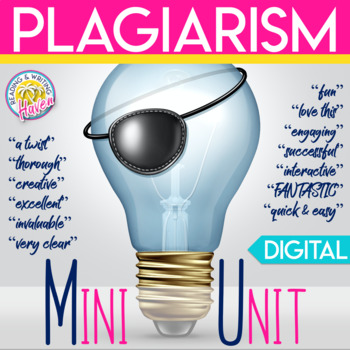Avoiding Plagiarism Unit: Engaging Plagiarism Lessons - Academic Integrity
- Zip
- Google Apps™

What educators are saying
Learning Objective
Students will learn about different types of plagiarism and three key ways to correctly cite research (paraphrasing, summarizing, and directly quoting) in order to prepare them for research writing in high school, college, and the workplace.
Description
Plagiarism...what a "downer" topic! For years, I dreaded teaching it because students thought I was the Wicked Witch who was out to get them for every missing quotation mark in their essays (or at least that's how I felt as I taught them about the rules of citing sources). In an effort to make writing in general more fun and accessible to students, I came up with fun, engaging, non-intimidating ways to approach plagiarism lessons. Teachers can convey the importance of plagiarism without putting everyone in a bad mood.
In this mini unit, which could take anywhere from 2-5 days if you have 45 minute class periods, you will find a handful of creative, differentiated tools to make plagiarizing clear and relevant.
NOTE: This unit started small and has grown larger over time. You can break this unit apart into smaller mini lessons and reinforcement activities, sprinkling them in throughout your curriculum. You can also use all of the resources included in learning stations.
CONTENTS
- A suggested lesson overview and pacing
- A presentation (14 slides covering what plagiarism is, how students can avoid it using paraphrasing, summarizing, and directly quoting, and what students can do if they are still confused)
- A teacher-created video lesson to accompany the presentation that you can use in distance learning or flipped classroom settings
- A student notes graphic organizer
- 4 short activity sheets that prompt students to read excerpts from high-interest texts about candy and then put their citation skills to the test
- 1 practice exercise that encourages students to paraphrase and directly quote the same research to help them understand the options they have for giving credit to the source
- A plagiarism task card game
- An engaging "Can You Spy the Plagiarism?" class activity
- 2 quizzes you can use as a pre- and post- test to get a baseline and track growth
- A video lesson pairing which can be used in class or for homework
- Links to further videos and full-text articles that you can use for additional practice, if necessary
- Suggested answer keys
Can I use this with distance learning?
Yes, absolutely! I just recently updated this unit. It's now 100% virtual and remote learning friendly for teachers and students. All digital activities are located in Google Drive on Slides and Forms documents. You can just click on the links located in the PDF download and add copies of the digital resources to your own Google Drive.
Who is this for and when can I use it?
This middle and high school mini-unit can be used at the beginning of the year, before any writing unit, as a refresher during the revision process, or even after passing back graded essays when students are allowed to fix their mistakes, learn from them, and resubmit for full or partial credit.
*Note: This lesson is intended to build upon students' prior knowledge. It does briefly review summarizing, paraphrasing, and directly quoting. However, the unit provides a holistic view of avoiding plagiarism, not an in-depth tutorial for the three ways to cite research. If your students have not already been introduced to these skills, I recommend supplementing with additional instruction.
I hope this unit makes teaching about plagiarizing more fun, relevant, and understandable for your students!
Loving these? Try these stoplight plagiarism revision and editing stations!
If you like this product, you may be interested in other writing and grammar products in my store, like these:
Email Etiquette Mini Unit: How to Email a Teacher
Writing an Effective Thesis Statement Lesson
Embedding Quotations in Research Papers
Argumentative Research Paragraph Instructional Materials
And more here!
Stay in touch:
~~~~~~~~~~~~~~~~~~~~~~~~~~~~~~~~~~~~~~~~~~~~~~~~~~~~~~~~~~
A Couple Tips:
* Be sure to click the "follow" button that is located next to my picture so that you can hear about sales and new products!
* By providing feedback on your purchased products, you can earn points, which ultimately translate into cash toward future purchases...bonus! Plus, I'd love to hear from you.
©Reading & Writing Haven
All rights reserved by author.
Duplication limited to single classroom use only.
Electronic distribution limited to single classroom use only.





